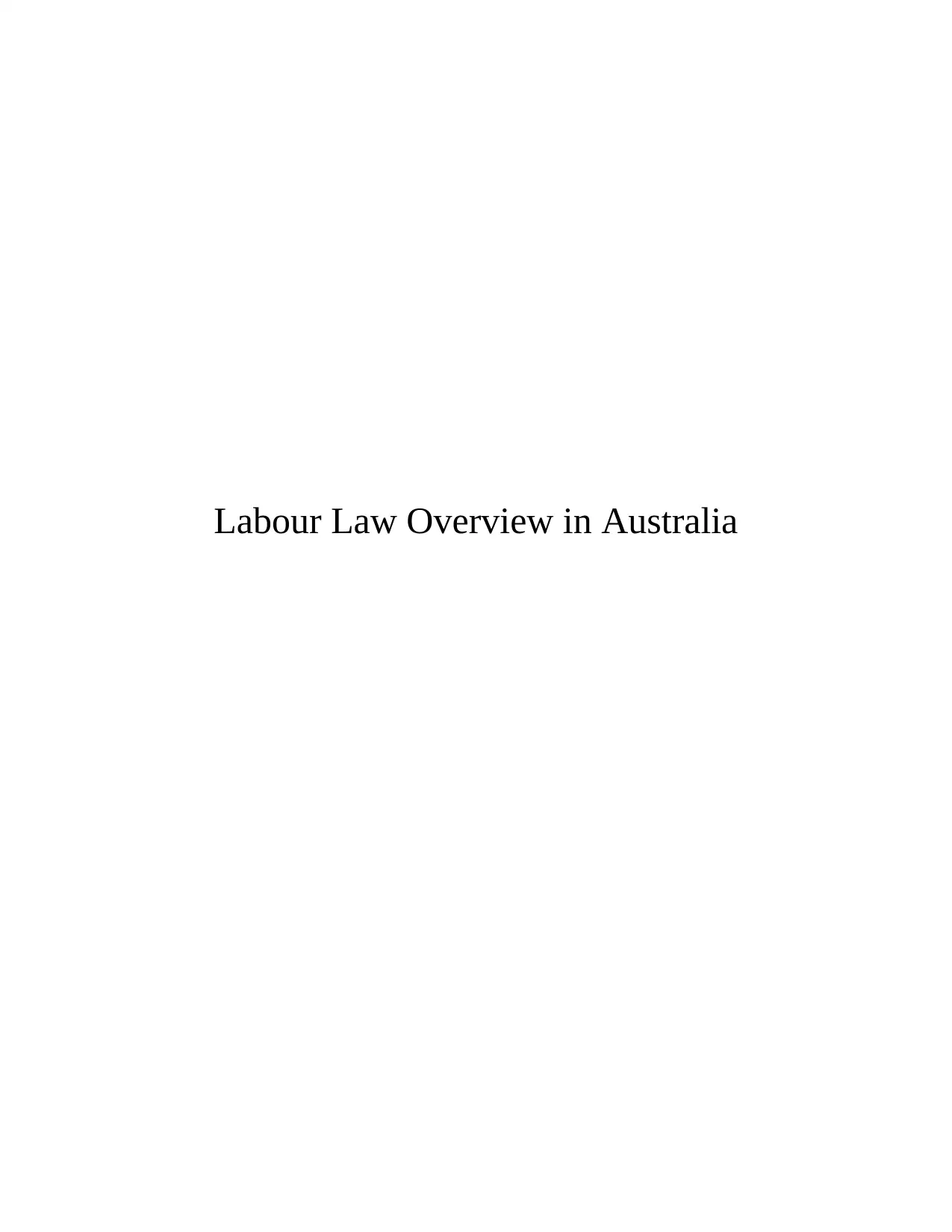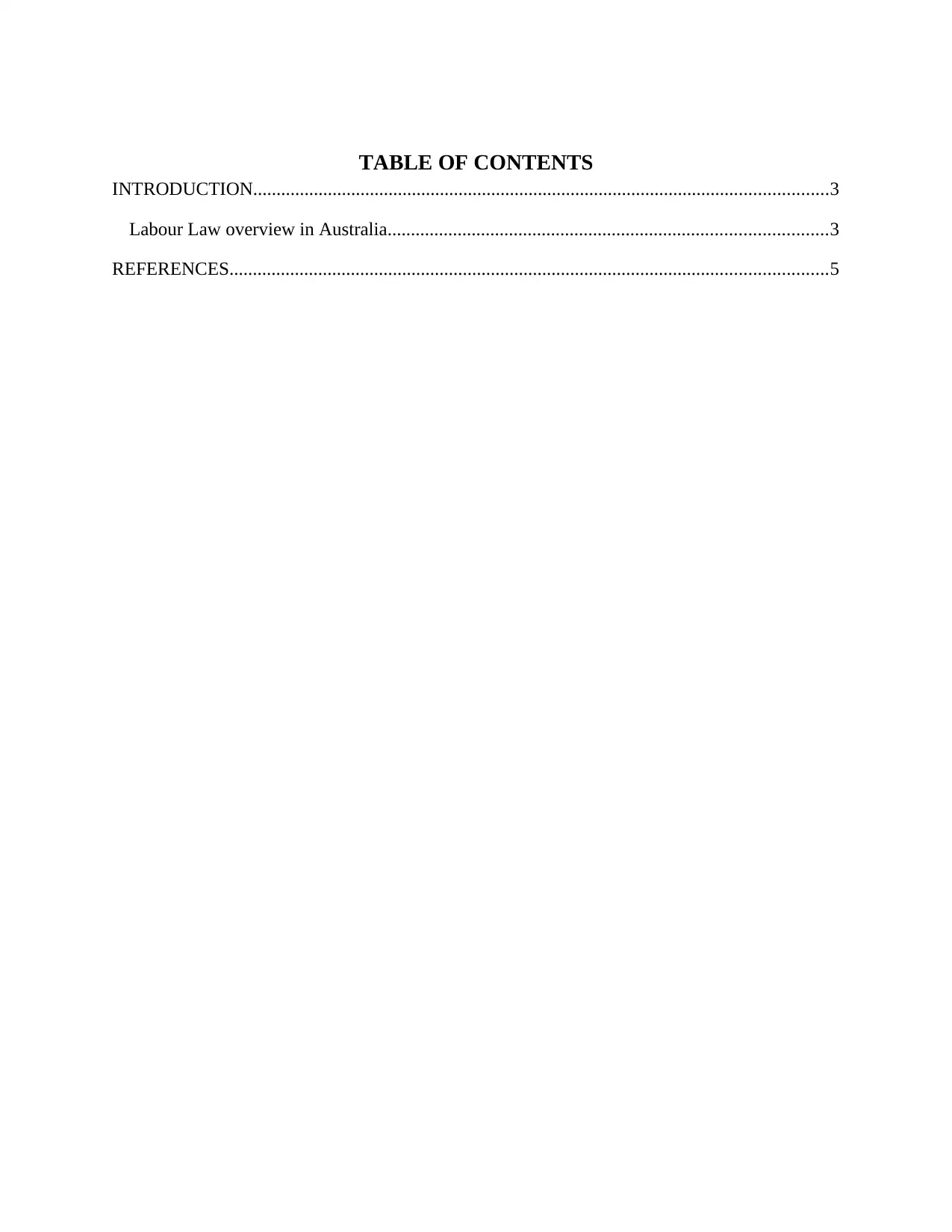Australia Labour Law: Fair Work Act and Modern Award Overview
VerifiedAdded on 2020/06/06
|5
|945
|67
Report
AI Summary
This report provides a comprehensive overview of Australian labour law, focusing on the Fair Work Act 2009 and its significance in regulating employment relationships. It outlines the key provisions of the Act, including minimum wages, enterprise bargaining, dispute resolution, and termination. The report also delves into the role of the Fair Work Commission and Fair Work Ombudsman in administering and enforcing the Act. Furthermore, it examines the Modern Award system, specifically the Hair & Beauty Industry Award 2010, highlighting its application to businesses within the hair and beauty sector. The report emphasizes the importance of compliance with these regulations to ensure a productive and harmonious workplace, and it touches upon the penalties for non-compliance. The study aims to investigate the application of the FW Act and Modern Award in a luxurious hairdressing salon, Aztec hair and Beauty Salon.

Labour Law Overview in Australia
Paraphrase This Document
Need a fresh take? Get an instant paraphrase of this document with our AI Paraphraser

TABLE OF CONTENTS
INTRODUCTION...........................................................................................................................3
Labour Law overview in Australia..............................................................................................3
REFERENCES................................................................................................................................5
INTRODUCTION...........................................................................................................................3
Labour Law overview in Australia..............................................................................................3
REFERENCES................................................................................................................................5

INTRODUCTION
Labour law comprises all the statutory standards, principles, rules and regulations that
business enterprises need to comply with to provide better working conditions and flexible
workplace. Fair work Act 2009 is centrepiece legislation that sets out employment terms and
conditions as well rights and responsibilities of employees and employers subjected to
employment. In Australia, all the organizations need to comply with so as to promote
harmonious, productive and cooperative workplace. The act also developed compliance &
enforcement regime in which, two regulatory bodies, Fair Work Australia (FWA) and Fair Work
Ombudsman (FWO) administers and regulates the act. In Australia, Hair & Beauty Australia
(HABA) is the only regulatory association that works with Fair Work Commission (FWC) to
mitigate the issues of unfair dismissal, biasness, discrimination, harassment and bullying. The
Act also contains Modern Award provisions that include minimum pay and other conditions of
employment that firms need to follow. In this regards, Hair & Beauty Industry Award 2010
applies for hair and beauty companies operating in Australia. Current study aims to investigate
the application of FW Act and Modern Award in Aztec hair and Beauty Salon that is a luxurious
hairdressing salon.
Labour Law overview in Australia
Before the coming of FW Act 2009, Workplace Relations Act 1996 was in place that
manages rules and regulations in respect to workplace conditions. However, later in 2009, Rudd
Government replaced the act by Fair Work Act 2009 which is the main source of labour law that
governs and regulates employment relationships (McCrystal, 2009). The main purpose of the act
is to create a balanced framework so as to create productive workplace that promotes economic
prosperity as well as social inclusion. The legislative framework applies to all the corporate
entities working in Australia that enforces rules and statutory provisions relating to minimum
wages, enterprise bargaining, dispute resolution, termination and others (Fair Work Legislation,
2016). However, if in any circumstance, an entity is found in breach to adhere with the FW Act
then it will be liable to pay penalty up to AUD 51,000 each breach. Thus, FW Act works as a
safety net for the employees that assures that minimum working conditions are provided to all
the workers and also prohibits unfair business practices against employees.
3
Labour law comprises all the statutory standards, principles, rules and regulations that
business enterprises need to comply with to provide better working conditions and flexible
workplace. Fair work Act 2009 is centrepiece legislation that sets out employment terms and
conditions as well rights and responsibilities of employees and employers subjected to
employment. In Australia, all the organizations need to comply with so as to promote
harmonious, productive and cooperative workplace. The act also developed compliance &
enforcement regime in which, two regulatory bodies, Fair Work Australia (FWA) and Fair Work
Ombudsman (FWO) administers and regulates the act. In Australia, Hair & Beauty Australia
(HABA) is the only regulatory association that works with Fair Work Commission (FWC) to
mitigate the issues of unfair dismissal, biasness, discrimination, harassment and bullying. The
Act also contains Modern Award provisions that include minimum pay and other conditions of
employment that firms need to follow. In this regards, Hair & Beauty Industry Award 2010
applies for hair and beauty companies operating in Australia. Current study aims to investigate
the application of FW Act and Modern Award in Aztec hair and Beauty Salon that is a luxurious
hairdressing salon.
Labour Law overview in Australia
Before the coming of FW Act 2009, Workplace Relations Act 1996 was in place that
manages rules and regulations in respect to workplace conditions. However, later in 2009, Rudd
Government replaced the act by Fair Work Act 2009 which is the main source of labour law that
governs and regulates employment relationships (McCrystal, 2009). The main purpose of the act
is to create a balanced framework so as to create productive workplace that promotes economic
prosperity as well as social inclusion. The legislative framework applies to all the corporate
entities working in Australia that enforces rules and statutory provisions relating to minimum
wages, enterprise bargaining, dispute resolution, termination and others (Fair Work Legislation,
2016). However, if in any circumstance, an entity is found in breach to adhere with the FW Act
then it will be liable to pay penalty up to AUD 51,000 each breach. Thus, FW Act works as a
safety net for the employees that assures that minimum working conditions are provided to all
the workers and also prohibits unfair business practices against employees.
3
⊘ This is a preview!⊘
Do you want full access?
Subscribe today to unlock all pages.

Trusted by 1+ million students worldwide

Objectives:
1. To develop legal regulations of employment conditions
2. To set out employees and employers rights as well as responsibilities in relation to
employment
3. To regulate and administrate the Act by Fair Work Commission and Fair Work
Ombudsman
All the workplace related matters are overseeing by an independent body, Fair Work
Commission while Fair Work Ombudsman is liable to investigate suspected violation of
workplace rights (Chapman, 2009). The Act comprises 10 National Employment Standards
(NES) which mandatorily needs to be followed by all the Australian companies regardless their
business sizes and sector in which they are operating. The standards consists of rules and
regulations on working hours, flexible working arrangements, leave, community service leave,
annual leave, long service leave, fair work statement, termination and others (Fair Work
Legislation, 2016).
Meaning of awards
Awards which are referred as modern award are the set of legal document that clearly
presents the minimum pay rates as well as employment conditions for the workers. Currently,
there are 122 total industry awards that cover all the people working in Australia.
Awards coverage
It applies to businesses and workers working in different sectors and the type of work
they perform. It includes two important things one is coverage clause and classification of job in
pay clause/schedule. However, on the other side, it does not apply for such entities that have a
registered agreement in place.
Hair & Beauty Industry Award 2010
FWC incorporated modern award in the FW Act which are additional guidelines as per
which, firms need to arrange employment arrangements. Hair and Beauty Industry Award 2010
commences since 1st January 2010 that comprises transitional arrangements regards minimum
wages, casual or part-time loading, holidays and penalties as well (Hair and Beauty Industry
Award, 2010). This award covers all the employers working in Australia in hair and beauty
sector. However, it does not include people who are employed in hair and beauty related work in
general retail, entertainment, theatrical and amusement industry.
4
1. To develop legal regulations of employment conditions
2. To set out employees and employers rights as well as responsibilities in relation to
employment
3. To regulate and administrate the Act by Fair Work Commission and Fair Work
Ombudsman
All the workplace related matters are overseeing by an independent body, Fair Work
Commission while Fair Work Ombudsman is liable to investigate suspected violation of
workplace rights (Chapman, 2009). The Act comprises 10 National Employment Standards
(NES) which mandatorily needs to be followed by all the Australian companies regardless their
business sizes and sector in which they are operating. The standards consists of rules and
regulations on working hours, flexible working arrangements, leave, community service leave,
annual leave, long service leave, fair work statement, termination and others (Fair Work
Legislation, 2016).
Meaning of awards
Awards which are referred as modern award are the set of legal document that clearly
presents the minimum pay rates as well as employment conditions for the workers. Currently,
there are 122 total industry awards that cover all the people working in Australia.
Awards coverage
It applies to businesses and workers working in different sectors and the type of work
they perform. It includes two important things one is coverage clause and classification of job in
pay clause/schedule. However, on the other side, it does not apply for such entities that have a
registered agreement in place.
Hair & Beauty Industry Award 2010
FWC incorporated modern award in the FW Act which are additional guidelines as per
which, firms need to arrange employment arrangements. Hair and Beauty Industry Award 2010
commences since 1st January 2010 that comprises transitional arrangements regards minimum
wages, casual or part-time loading, holidays and penalties as well (Hair and Beauty Industry
Award, 2010). This award covers all the employers working in Australia in hair and beauty
sector. However, it does not include people who are employed in hair and beauty related work in
general retail, entertainment, theatrical and amusement industry.
4
Paraphrase This Document
Need a fresh take? Get an instant paraphrase of this document with our AI Paraphraser

REFERENCES
Books and Journals
Chapman, A. (2009). Protections in Relation to Dismissal: From the Workplace Relations Act to
the Fair Work Act. UNSWLJ. 32. 746.
McCrystal, S. (2009). The Fair Work Act 2009 (Cth) and the Right to Strike’(2009). Australian
Journal of Labour Law. 23. 3.
Online
Fair Work Legislation. (2016). [Online]. Available through: <
https://www.fairwork.gov.au/about-us/legislation>.
Gates, K. (2013). Employment Law in Australia. [PDF]. Available through:
http://www.klgates.com/files/Upload/DoingBusinessInAustralia_Employment_Law.PDF.
Hair and Beauty Industry Award. (2010). [Online]. Available through: <
http://awardviewer.fwo.gov.au/award/show/MA000005>.
5
Books and Journals
Chapman, A. (2009). Protections in Relation to Dismissal: From the Workplace Relations Act to
the Fair Work Act. UNSWLJ. 32. 746.
McCrystal, S. (2009). The Fair Work Act 2009 (Cth) and the Right to Strike’(2009). Australian
Journal of Labour Law. 23. 3.
Online
Fair Work Legislation. (2016). [Online]. Available through: <
https://www.fairwork.gov.au/about-us/legislation>.
Gates, K. (2013). Employment Law in Australia. [PDF]. Available through:
http://www.klgates.com/files/Upload/DoingBusinessInAustralia_Employment_Law.PDF.
Hair and Beauty Industry Award. (2010). [Online]. Available through: <
http://awardviewer.fwo.gov.au/award/show/MA000005>.
5
1 out of 5
Related Documents
Your All-in-One AI-Powered Toolkit for Academic Success.
+13062052269
info@desklib.com
Available 24*7 on WhatsApp / Email
![[object Object]](/_next/static/media/star-bottom.7253800d.svg)
Unlock your academic potential
Copyright © 2020–2025 A2Z Services. All Rights Reserved. Developed and managed by ZUCOL.





